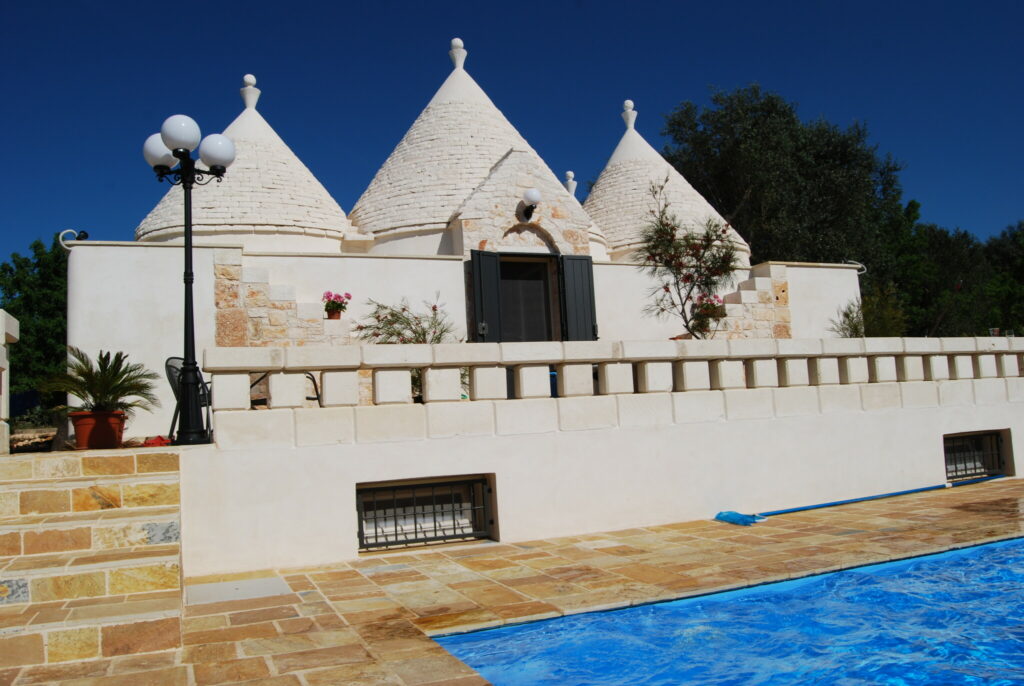Puglia, sometimes referred to as Apulia in English, covers the southern most part of the east coast of Italy, forming the distinctive ‘heel of the boot’ of Italy.
Puglia is a diverse and beautiful region, with over 800km of coastline – the most of any Italian mainland region. Its landscape ranges from from dramatic rocky cliff faces to white sandy beaches. Rolling hills and mountains descend onto rich, fertile plains filled with innumerable olive trees and vineyards that fill the wine bottles of Europe and the rest of the world. Its towns and cities are a major attraction, with stories going back to the beginning of time. Dramatic architecture inspired by religion, war and wealth appears around every corner and in the most unlikely of places.
Puglia has a population of c.4.1 million people, and covers a land area of 19 345 km2.
The regional capital of Puglia is Bari The region is divided into six administrative provinces, from north-west to south-east:
- Foggia
- Barletta-Andria-Trani
- Bari
- Taranto
- Brindisi
- Lecce
For convenienece, our detailed information about places and attractipns in Puglia is divided into the six provinces. We set out some broader background about each province here.
Foggia Province
The Province of Foggia is made up of three distinct parts – the lowlands around the city of Foggia; the Gargano peninsula projecting like a “spur” on the “heel” of Italy on the west; and Daunia to the east.
The flat area around Foggia itself is a vitally important agricultural area, producing wheat and other crops in large quantities alongside extensive vineyards.
The Gargano is a relatively mountainous area (certainly in comparison with the rest of Puglia, Italy’s least mountainous region), jutting out into the Adriatic Sea. Much of this highland area is covered by the Gargano National Park, containing the Foresta Umbra, an ancient oak and beech forest.
To the west of Foggia is the mountainous region of Daunia, populated with towns and villages nestling amongst the rolling hills, including Bovino, a member of the ‘Italy’s Most Beautiful Villages’ club.
Foggia Province has population of c.640k, and covers a land area of 6 960 km2.
Barletta-Andria-Trani Province
Barletta-Andria-Trani was only created as a province in 2009 from a number of communes that were previously part of either the Foggia or Bari provinces. The capital is Andria, but all three cities forming the name of the province share it’s administration.
In recent years this part of the region has been ‘re-branded’ as Puglia Imperiale, intending to bring benefit to all the towns and cities in the province from the popularity of the UNESCO World Heritage Site, Castel Del Monte. This impressive octagonal shaped castle was constructed by Frederick II, the powerful Holy Roman Emperor and head of the House of Hohenstaufen during the 13th Century, who had a widespread and lasting influence across Puglia.
The Province of Barletta-Andria-Trani has a population of c.400k people, and covers a land area of 1 543 km2.
Bari Province
The province of Bari dominates the central area of the region of Puglia and contains the regional capital towards the north. There are a handful of other larger cities north of Bari, such as Bitonto and Corato, both notable for their olive oil produce. Further south is the Itria Valley, famous worldwide for the unique conical shaped ‘trulli’ buildings that are scattered around the landscape. Alberobello is located here, the town made up of 1400 trulli, another of Puglia’s UNESCO World Heritage Sites.
Flat along the Adriatic coast, Bari province is dominated inland by the Murgia hills. Although these only reach 700m at their highest, they present a very bare, bleak landscape, in sharp contrast to much of Puglia. This area includes the Alta Murgia National Park The rock is primarily Cretaceous limestone, which lends itself to the formation of sink-holes and caves, most notably those at Castellana Grotte which are well worth including in any itinerary for a holiday in the area. Just over the border into the region of Basilicata is the city of Matera, details of which are included in the website despite not quite being within Puglia.
Bari Province has a population of c.1.2 million, and covers a land area of 3 821 km2.
Taranto Province
The Province of Taranto is the only one of the six Puglian provinces not to border the Adriatic Sea, with all its coastline being on the Ionian. The capital city of Taranto has ancient origins, known as ‘The Spartan City’ after its founders, who established a colony here in the 7th Century BC. Subsequently known as Tarentum by the Romans, the city benefits from a natural harbour and is the location of the main naval base for the Italian military.
The province reaches north to the grand baroque town of Martina Franca; in the west lies the town of Laterza, renowned for it’s bread and a 12km long canyon; and Manduria, the home of the Primitivo grape, in the east.
Taranto Province has a population of c.580k, and covers a land area of 2 437 km2.
Brindisi Province
The second smallest of the Puglian provinces, Brindisi contains the southern parts of the Murgia hills and the Itria Valley, as well as having a long Adriatic coastline with many sandy beaches. The province also contains the northern part of the Salento, the name given to the wine and olive producing area which extends to the tip of the “heel” of Italy.
The city of Brindisi, one of the largest natural harbours in the Mediterranean, has been a major port for over two thousand years and was the end point of the Via Appia Traiana, one of the great Roman roads which ran the length and breadth of the Italian peninsula (parts of which still remain throughout the region).
The landscape is dominated by vineyards and olive groves, with agriculture making up a large portion of the economy. Other than the city of Brindisi, Ostuni and Oria are the main locations on the tourist trail; Ostuni for it’s cathedral and distinctive whitewashed Norman town walls and dwellings, Oria for it’s 13th Century castle, another of Frederick II’s legacies.
Brindisi Province has a population of c.400k, and covers a land area of 1 839 km2.
Lecce Province
The Province of Lecce occupies the very tip of the ‘heel’ of Italy and the Salento Peninsula, surrounded by the Adriatic Sea to the east and the Ionian sea to the south/west.
The city of Lecce is often referred to as the ‘Florence of the South’, but this is something of a misnomer, since it is dominated by baroque architecture, and there is a well preserved Roman amphitheatre in the centre. Many other nearby towns follow a similar architectural style, such as Nardo, Galatone and Galatina.
Gallipoli, the ‘Gem of Salento’, on the Ionian coast, Otranto on the Adriatic coast, and Tricase in centre of the peninsula are the three main towns of note. At the southernmost tip is Santa Maria di Leuca, where the Ionian and Adriatic seas meet, which has been a tourist destination for the well-to-do Pugliesi since 1900. Surrounded by the sea on three sides, this province offers exceptional opportunities for scuba diving, water sports and explorations into caves hewn into the cliff faces by the wind and sea over many millennia.
Lecce Province has a population of c.800k, and covers a land area of 2 759 km2.

